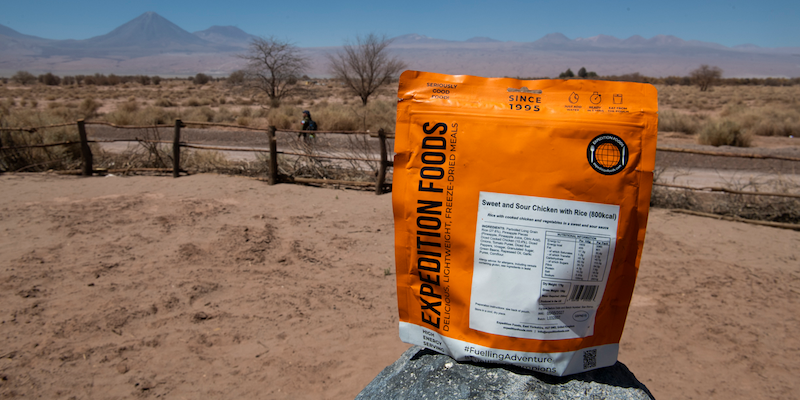-
Meals
-
Ration Packs
-
Special Diets
- Survivor Foods 25-Year Tins
-
Snacks, Drinks & Accessories
- About Us
Marathon Des Sables: My Unconventional Sahara Tricks
March 08, 2023

Gaël Dutigny is a French journalist living in Southern California. An 8-time finisher of the Marathon Des Sables (and of 4 UTMBs and 17 Ironman triathlons, too), he shares his tips and tricks for a desert race.
"The Marathon Des Sables (MDS) is no small feat... It's not so much the distance or the cut-off times that make it difficult. It's the environment. The race will take place soon in Morocco, in the northern part of the Sahara Desert. There is plenty of time to change the gear that does not work great at this stage. If you can stand a bit of discomfort and want to protect your eyes, your shoulders, and your back, read on.
What shoes to wear?
This is as important as it is tricky. The only rule I see, looking back at my eight finishes, is that they need to be comfortable for you and have a high stack height (30 mm is what I like). The higher the height, the better: the plush and cushioning of the midsole will protect your joints, your tendons and limit weariness over time. This is a 7-day stage race (6 stages) so the more you can prevent fatigue, the better.
Hoka? Their stack height is always good for the MDS but I find most of their shoes too narrow. It's a personal flaw: I easily get blisters. Altra is my other go-to brand for the MDS.
Whether it's a road shoe or a trail running shoe doesn't matter. The terrain is not going to deteriorate a road shoe in 7 days. The Sahara is not like the Alps or the Himalayas. There are not many rocks but mostly dunes and drier sand paths. The size of the shoe is the real question. It is true that half a size bigger than your usual running shoe, or even a full size bigger, is a great idea. Eighty percent of the runners get blisters. Both feet swell because of the heat and all that salt they give you and that you absolutely must swallow. But, I know people who wear regular shoe sizes and have no problems.
Bottom line: do what you're comfortable with but consider the rule of one size bigger. Also, carefully preparing your feet before the race will prevent you from terrible blisters that force many runners to DNF after only a few days of racing every year. Weeks before the event, gradually eliminate excesses of dead skin and calluses.

@JOSUEFPHOTO
What clothes to wear?
The clothes you're going to bring for the race will stay with you for 6 stages over 7 days.
- I carry two pairs of socks, maybe three. Your feet are your most precious allies. Socks may get sandy, bloody, wet, and sweaty, and that's OK. But if you get bad blisters with a beginning of infection you will want to wear clean socks as much as possible. Two pairs are a must. I am not a fan of the toe-sock style sock, because they don’t leave space to tape your toes if needed.
- Compression. Chafing can be a real issue in the desert. A compression short will limit that and give you peace of mind. I wear baggier running shorts with waist-type pockets on top both for style and convenience. I also use Vaseline around my crotch every morning. At night, I wear a recovery compression tight. I do wear compression tubes on my calves during the day but I remove them at night.
- As a top, because again I want to have more storage options, I like a long sleeve button-down shirt with deep chest pockets (I always use a Patagonia). Whether it's a proper technical running shirt (Rabbit is a great brand for that), a vintage military shirt, or a regular cotton shirt makes no difference to me (wet cotton with sweat will keep you cooler. That’s a Badwater trick).
- Sunglasses and a trucker hat are a must, as well as ultra-light motocross goggles. Yes. You read that right. Motocross goggles. In 2022, when we had a really bad sandstorm for an entire day, motorcross goggles did the trick. Motocross goggles are both cheaper and lighter than ski ones. Here you go. Motocross goggles. My gift to you people.
What sleeping bag to bring?
I've done it all: from heavy-duty mountaineering bags to way-too-light ones. I've been so cold one year that I was up shivering every night from 2 to 4 am. Not fun. I've also been so hot and sweaty that sleeping entirely naked wasn't enough to cool me down. The problem is that the weather in the Sahara is unpredictable. As a rule of thumb though, you must expect the nights to be surprisingly cold.
What you can tolerate in terms of comfort will determine how well you want to sleep at night. Last year, I brought four emergency sleeping bags. They were cheap, small, about the size of a pair of socks, not that fragile and of course very light. Every two nights, I was tossing one. This year, I’m taking one for every night. They are not breathable – like at all - but they keep you warm enough. The trick of the trade is to bring a waterproof outer bag that you can use as a primary bag, on top of which you put on those silly survival sleeping bags. That way, your sweat goes out through the rather breathable waterproof outer bag and does not come back to haunt you. I think it's brilliant and I’m particularly proud of this. I’m not even joking! Those emergency sleeping bags save a ton of weight as well as space in your backpack, not to mention some money.

@JOSUEFPHOTO
What food to pack?
Also in Stories

Government Recommended Emergency Kit
November 21, 2024

Karakoram Mountains of Northern Pakistan
October 25, 2024

Antarctic Fire Angels - Union Glacier to the South Pole
September 12, 2024


